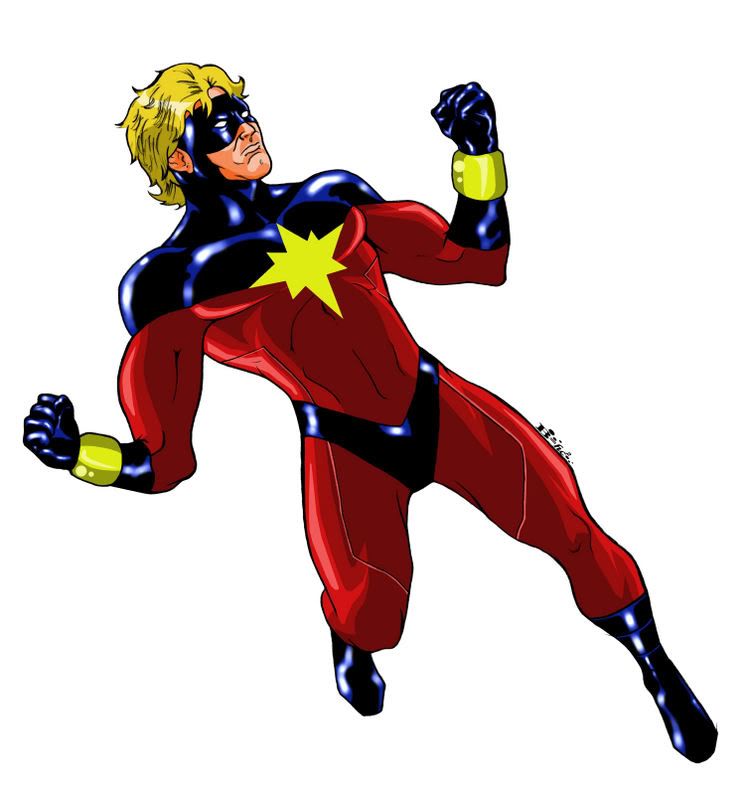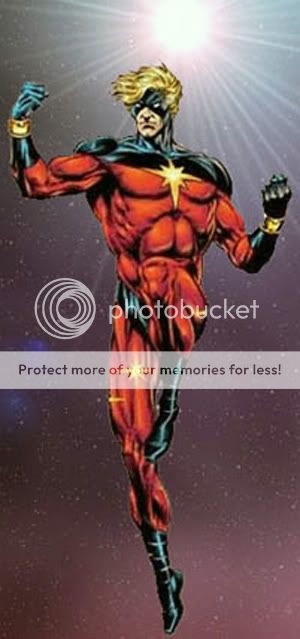Captain Marvel (Mar-Vell) is a fictional character owned by Marvel Comics. The character was created by writer-editor Stan Lee and designed by artist Gene Colan and first appeared in Marvel Super-Heroes #12 (Dec. 1967).
The character debuted during the Silver Age of comic books and has made many appearances since then, including a self-titled series and the second volume of the title Marvel Spotlight. Captain Marvel has also been associated with Marvel merchandise including clothing; video games; toys and trading cards.
Marvel's character debuted as the lead feature in Marvel Super-Heroes #12 (December 1967), written by Stan Lee and illustrated by Gene Colan. Shortly thereafter he was given his own series, commencing with Captain Marvel #1 (May 1968). The series failed to register with readers, and the series was revamped by writer-artist team Roy Thomas and Gil Kane in issue #17 (October 1969). The character was given a new uniform, designed by Kane and colorist Michelle Robinson, and greater abilities. An added plot feature was the introduction of sidekick Rick Jones. Jones and Marvel "shared molecules" allowing only one to exist in the real world at a time. Thomas stated that the intent of the change was to create a more science-fiction oriented update that was reminiscent of Fawcett Comics's original Captain Marvel, who similarly had an alter-ego that could not co-exist with the superhero.
The change, however, was not successful, and the series was published only intermittently from 1969. It was initially canceled with issue #21 (August 1970), though the character appeared in the Kree-Skrull War storyline in Avengers #89 - 96 (June 1971 - March 1972), also written by Thomas. In 1972 plotter and artist James Starlin decided to revamp the character, with the series recommencing with issue #22 (Sept. 1972). A spin-off series, Ms. Marvel, was launched in 1977, but sales remained modest, and the series was published on only a bimonthly basis until it was ultimately canceled in 1979.
The continued publication, however, kept the trademark current. This had the effect of requiring DC Comics, which in the meantime licensed the original Fawcett Captain Marvel for publication, to print its new comics under the trademark Shazam!. Comics historian Don Markstein states, "Marvel didn't seem to quite know what to do with him—but they did put his comic out every other month through most of the 1970s, if only to maintain their trademark on his name..."


Upon his arrival on Earth, Mar-Vell possessed no superhuman (or super-Kree) powers apart from being stronger and more durable than most humans due to his advanced Kree physiology; the Kree have evolved with higher physical-strength levels than humans to combat the heavier gravitations of their home planets. As a soldier, the character is equipped with a device called a "universal beam" (or "uni-beam," at first a handheld pistol but later converted into a wrist-mounted device) that is capable of projecting energy; emitting beams of pure blackness and controlling magnetism.
When manipulated by "Zo" (actually Zarek, the Kree Imperial Minister), Mar-Vell gained the ability to teleport to anywhere in the universe, as well as the ability to mentally project illusions. These abilities were lost when Mar-Vell gained the Nega-Bands, which convert Mar-Vell's psionic energy into greater strength and durability, energy projection, and the power to fly at faster-than-light speeds and traverse vast interstellar and intergalactic distances and enable him to exist unprotected in deep outer space without having to breathe.
Once he is named the "Protector of the Universe" by Eon, Mar-Vell gains "cosmic awareness," which (among other things) allows him to detect threats and perceive changes in the universe as long as they are important to him for some reason. The full range and extent of this ability has never been clearly defined, although it was once described as comparable to Spider-Man's "spider-sense," albeit on a larger scale. This awareness can also be used internally, which alerted him to his terminal cancer even before he went to have it medically confirmed.
Mar-Vell's Kree military training gives him mastery of all forms of unarmed combat and extensive knowledge of the technology of the Kree Empire.
The character debuted during the Silver Age of comic books and has made many appearances since then, including a self-titled series and the second volume of the title Marvel Spotlight. Captain Marvel has also been associated with Marvel merchandise including clothing; video games; toys and trading cards.
Marvel's character debuted as the lead feature in Marvel Super-Heroes #12 (December 1967), written by Stan Lee and illustrated by Gene Colan. Shortly thereafter he was given his own series, commencing with Captain Marvel #1 (May 1968). The series failed to register with readers, and the series was revamped by writer-artist team Roy Thomas and Gil Kane in issue #17 (October 1969). The character was given a new uniform, designed by Kane and colorist Michelle Robinson, and greater abilities. An added plot feature was the introduction of sidekick Rick Jones. Jones and Marvel "shared molecules" allowing only one to exist in the real world at a time. Thomas stated that the intent of the change was to create a more science-fiction oriented update that was reminiscent of Fawcett Comics's original Captain Marvel, who similarly had an alter-ego that could not co-exist with the superhero.
The change, however, was not successful, and the series was published only intermittently from 1969. It was initially canceled with issue #21 (August 1970), though the character appeared in the Kree-Skrull War storyline in Avengers #89 - 96 (June 1971 - March 1972), also written by Thomas. In 1972 plotter and artist James Starlin decided to revamp the character, with the series recommencing with issue #22 (Sept. 1972). A spin-off series, Ms. Marvel, was launched in 1977, but sales remained modest, and the series was published on only a bimonthly basis until it was ultimately canceled in 1979.
The continued publication, however, kept the trademark current. This had the effect of requiring DC Comics, which in the meantime licensed the original Fawcett Captain Marvel for publication, to print its new comics under the trademark Shazam!. Comics historian Don Markstein states, "Marvel didn't seem to quite know what to do with him—but they did put his comic out every other month through most of the 1970s, if only to maintain their trademark on his name..."


Upon his arrival on Earth, Mar-Vell possessed no superhuman (or super-Kree) powers apart from being stronger and more durable than most humans due to his advanced Kree physiology; the Kree have evolved with higher physical-strength levels than humans to combat the heavier gravitations of their home planets. As a soldier, the character is equipped with a device called a "universal beam" (or "uni-beam," at first a handheld pistol but later converted into a wrist-mounted device) that is capable of projecting energy; emitting beams of pure blackness and controlling magnetism.
When manipulated by "Zo" (actually Zarek, the Kree Imperial Minister), Mar-Vell gained the ability to teleport to anywhere in the universe, as well as the ability to mentally project illusions. These abilities were lost when Mar-Vell gained the Nega-Bands, which convert Mar-Vell's psionic energy into greater strength and durability, energy projection, and the power to fly at faster-than-light speeds and traverse vast interstellar and intergalactic distances and enable him to exist unprotected in deep outer space without having to breathe.
Once he is named the "Protector of the Universe" by Eon, Mar-Vell gains "cosmic awareness," which (among other things) allows him to detect threats and perceive changes in the universe as long as they are important to him for some reason. The full range and extent of this ability has never been clearly defined, although it was once described as comparable to Spider-Man's "spider-sense," albeit on a larger scale. This awareness can also be used internally, which alerted him to his terminal cancer even before he went to have it medically confirmed.
Mar-Vell's Kree military training gives him mastery of all forms of unarmed combat and extensive knowledge of the technology of the Kree Empire.









Comment